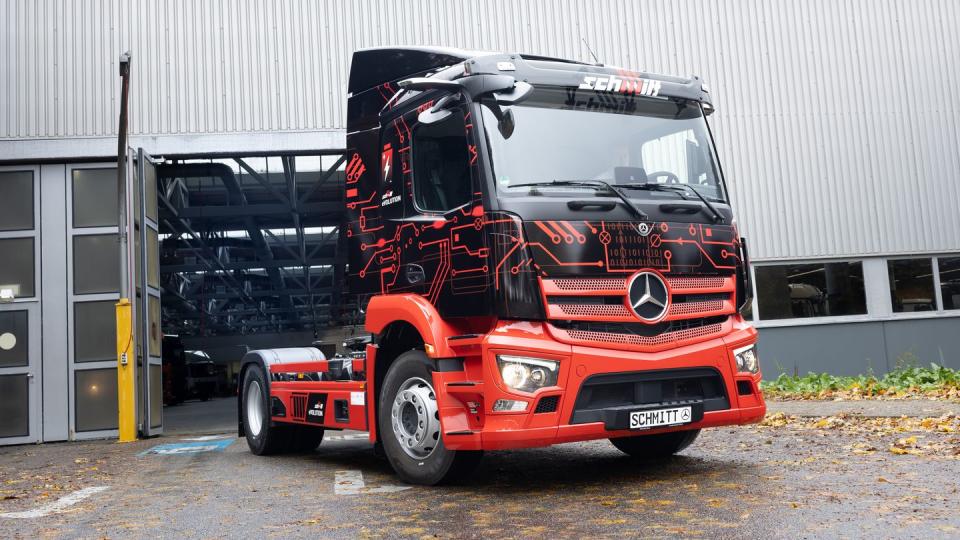This Mercedes-Benz Will Lead the EV Truck Shift

Daimler Truck delivers the first Mercedes-Benz eActros 300 to a fleet customer, with Logistik Schmitt having ordered several of these 4x2 electric semis.
The eActros 300 features three battery packs rated at 112 kWh each, giving it a range of 136 miles.
This type of semi is not aimed at long-haul routes, but rather local deliveries, and does not need megawatt-level charging to be used by a fleet, requiring a little over an hour to go from 20% to 80% state of charge.
Electric semi trucks have yet to begin appearing on roads in North America in noticeable numbers, but the picture in Europe is a little different. Several European truck makers have already started production of several semi trucks models aimed at daily routes, as well as long-haul routes.
In late October Mercedes-Benz delivered its first eActros 300 semi truck—one of several electric models it produces—to a customer as part of an initial order of six trucks. The eActros 300 semi, powered by three battery packs rated at 112 kWh each, was handed over to Rainer Schmitt, managing partner of Logistik Schmitt, and will be used for local deliveries.
The transport specialist firm, based in Bietigheim, Baden-Württemberg, Germany, will use the semi to deliver engines from its logistics plant in Germersheim to a Mercedes-Benz plant in Wörth, some 16 miles away.
"Logistik Schmitt has been an important partner for testing the eActros since 2019," said Ronald Ott, head of sales trucks, Mercedes-Benz and FUSO Germany. "From the first prototype to the electric articulated truck—Logistik Schmitt has supported the development steps of the e-truck with intensive tests."
In this particular configuration, the eActros 300 semi has a range of 136 miles on a single charge, and will be used by Logistik Schmitt in several shifts, with a charging station on site. Designed for charging speeds of up to 160 kW, the eActros 300 will require a little over an hour to go from 20% to 80% state of charge.
The eActros 300 is one of the shorter-range models the truck maker currently offers. At the other end of the battery-size spectrum is the eActros Long-Haul, scheduled to enter production in 2024 after an official reveal just weeks ago.
The Long-Haul model will feature a 600-kWh battery, good for a range of 500 kilometers or 310 miles, and will be aimed at fleet customers making longer runs, usually between port cities in the country's north and industrial hubs in the interior.
But it will also be somewhat dependent on a megawatt-level charging network, which has yet to be built.
Unlike the long-haul model, the eActros 300 does not really need megawatt-level charging—the 160-kW fast-charging stations that customers like Logistik Schmitt have will suffice, as the trucks won't really have a need to stray outside of their usual working routes.
It is this particular segment, one aimed at daily routes, that is expected to kick start Europe's electric truck revolution.
The long-haul trucks, meanwhile, are expected to become more of a regular sight in the next decade, as megawatt-level charging has yet to become a reality in northern Europe, from which the the majority early adopters are expected to come.

Another crucial element, besides the truck itself, has been the fact that Logistik Schmitt began developing its own charging infrastructure some time ago, putting it far ahead of fleets that are only now beginning to look at electric models.
Needless to say, the eActros 300 will be more suited to some fleets more than others, and won't displace diesel trucks for longer routes overnight. But it is steps like these that are bound to kick off an industry-wide shift in Germany's transport sector, with fleets that will have their own charging infrastructure.
Will we see electric semi trucks begin to displace diesel trucks in the US in this decade, or is it something that we'll only see in the 2030s or later? Let us know what you think.

 Yahoo Autos
Yahoo Autos 